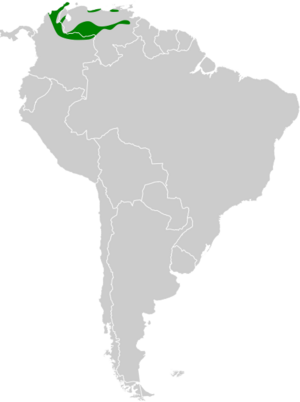Todd's nightjar facts for kids
Quick facts for kids Todd's nightjar |
|
|---|---|
| Conservation status | |
| Scientific classification | |
| Genus: |
Setopagis
|
| Species: |
heterura
|
 |
|
| Synonyms | |
|
Caprimulgus parvulus heterurus |
|
The Todd's nightjar (scientific name: Setopagis heterura) is a type of bird. It belongs to a family of birds called nightjars. You can find this bird in countries like Brazil, Colombia, Guyana, and Venezuela.
Contents
About Todd's Nightjar
Scientists used to think the Todd's nightjar was a type of Anthony's nightjar or little nightjar. But after looking closely at its genes, feathers, and calls, they decided it was its own unique species.
Another name suggested for it was the Santa Marta nightjar. This name came from the Santa Marta Mountains in Colombia. However, this name was not used because the bird lives in many more places than just those mountains. The Todd's nightjar is a monotypic species, which means it is the only member of its group.
What Does Todd's Nightjar Look Like?
Todd's nightjar birds are about 17 to 21 centimeters (7 to 8 inches) long.
Male Nightjars
Male Todd's nightjars are usually gray on top. They have blackish and buff (light yellowish-brown) streaks and spots. Around their neck, they have a thin cinnamon-colored band. Their throat is white, and their chest is dark brown with small bars and spots.
When they fly, you can see white patches on both the top and bottom of their wings. Most of their tail feathers have bright white tips.
Female Nightjars
Female Todd's nightjars have a darker crown (the top of their head). Their throat is buffy, and they do not have white tips on their tail feathers.
Tail Length
Both male and female Todd's nightjars have shorter tails than other nightjars that live in the same areas.
Where Do Todd's Nightjars Live?
Most Todd's nightjars live in northeastern Colombia and in northern and central Venezuela. There has been one sighting in Guyana and two in the very northern part of Brazil.
Preferred Homes
Todd's nightjars like to live in different kinds of places. These include the edges of forests where trees lose their leaves (deciduous woodlands). They also live near "gallery forests," which are forests that grow along rivers. You can also find them in open woodlands and even in parks in towns. They seem to prefer slightly hilly areas.
They can live from sea level up to about 1,000 meters (3,300 feet) high in Venezuela. However, in Colombia, they are usually found at lower elevations.
How Todd's Nightjars Behave
What Todd's Nightjars Eat
Todd's nightjars hunt for food by flying out from the ground or a low branch. They mostly eat insects. Scientists are still studying their diet to learn more about it.
Reproduction and Life Cycle
Scientists are still learning about when Todd's nightjars breed. It seems that their breeding season might be different depending on where they live.
Female nightjars lay two eggs directly on the ground. They usually choose a spot under a bush to lay their eggs.
What Todd's Nightjars Sound Like
The song of the Todd's nightjar sounds like an even-pitched "pik-you, gobble-gobble-gobble." They sing this song from the ground or a low branch. Scientists do not know if they make any other calls.
Conservation Status
The IUCN (International Union for Conservation of Nature) has decided that the Todd's nightjar is a species of "Least Concern." This means they are not currently in danger of disappearing.
They live in a fairly large area. Even though we don't know exactly how many Todd's nightjars there are, their population is thought to be stable. They seem to be rare in Colombia but are uncommon to fairly common in Venezuela. They also live in some protected areas, which helps keep them safe.


